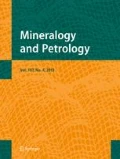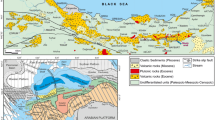Summary
We present a detailed isotopic study of volcanic rocks emitted from Somma–Vesuvius volcano during three periods of interplinian activity: “Protohistoric” (3550 y B.P. to 79 A.D.), “Ancient Historic” (79 to 472 A.D.) and “Medieval” (472 to 1631 A.D.). Pb isotopic compositions of two acid leached fractions and whole rock residues of 37 whole rock samples (determined by Somma et al., 2001) show that each of the three interplinian periods is distinguished by small, systematic, and unique uranogenic and thorogenic Pb isotopic trends. This key and novel feature is compatible with the notion that the Pb isotopic data reflect small-scale source heterogeneity operating over relatively short periods of time. From this representative group of samples, a selected set of nine whole rocks were analysed for Th isotopes. 232Th/238U ratios in the source can be obtained independently from Pb and from Th isotopes. Those obtained from Pb isotopes represent source ratios, time-integrated over the whole age of the Earth; they range from 3.9 to 4.1. 232Th/238U obtained from Th isotopes are those of the present source. They are lower, and cluster around 3.5; this difference probably indicates recent U enrichment of the present source.
The behaviour of Pb, as inferred by its isotopic ratios, is quite distinct from that of Sr and Nd isotopes: Pb isotope variations are not correlated to Sr or Nd isotope variations. The isotopic contrast is compatible with the idea that the isotopes were decoupled during magmatic production, evolution, and ascent through the crust. Thus, the Pb isotopes do not reflect the effects of the same processes as in the case of the Sr and Nd isotopes, or, as we also favor, they do not necessarily reflect the same source contributions into the magmas. Moreover, the Pb isotopic evolution of the interplinian rocks chiefly reflects mixing, driven by processes that are superimposed on, and independent of, other source contributions that determine the isotopic compositions of Sr and Nd. We suggest that reactions between magmas and fluids transported Pb and U, but not Sr. These data show that isotope mixing in the mantle is active at different times and scales.
Similar content being viewed by others
Author information
Authors and Affiliations
Rights and permissions
About this article
Cite this article
Cortini, M., Ayuso, R., De Vivo, B. et al. Isotopic composition of Pb and Th in interplinian volcanics from Somma–Vesuvius volcano, Italy. Mineralogy and Petrology 80, 83–96 (2004). https://doi.org/10.1007/s00710-003-0023-3
Received:
Accepted:
Issue Date:
DOI: https://doi.org/10.1007/s00710-003-0023-3




